SECTION 4: CONVEYING
"Care and diligence bring luck."
-- Thomas Fuller, M.D., 1732
English physician, writer
Auger entanglements involving all types of equipment, such as portable augers, combines, and grain wagons, were the second largest single source of grain-handling fatalities for the period 1985 through 1989. This section will discuss ways to reduce the risk of losing a limb or dying from an auger entanglement by avoiding contact with grain-conveying equipment and by protecting yourself in case contact should occur.
This section is the fourth part of a five-part handbook on grain- and silage-handling hazards. Each of the five sections of this handbook is meant to stand alone, so some hazards will be discussed in more than one section. If you have already read one of the other sections of this handbook, some of the material in this section may be a review for you.
Avoiding Machine Contact
To prevent contact with grain-conveying equipment, try to work on a stable, level surface. For example, place portable conveyors on dry, level ground. Consider placing gravel on the unloading areas to provide better footing. Grain spills should be cleaned up between each load, only after all of the equipment has been shut off and has stopped rotating, so workers are not standing on loose grain. The chances are less that workers will slip and become entangled if they work with a secure footing.
Keep your hands and feet from the intake areas of augers and elevators. For example, don't level or redirect the flow of grain into the auger or elevator with your hands or feet. Avoid the temptation to use a paddle elevator as a ladder. The risk of injury or death from falling, from becoming caught in the elevator, or from having the elevator collapse on you is not worth the few seconds saved.
Guarding
Guarding can help protect you from injury in case you do slip and contact the machinery. Belts, chains, intake areas, and drive shafts of conveying equipment should be guarded. Guards should be used on the intake areas of portable grain augers and augers that are part of other machines (Figure 4-1). Guards can be installed on older equipment. Pay special attention to children, since their hands and feet may be small enough to fit through the normal-sized openings of the intake guards. Consider installing flexible flighting on the intake portion of grain augers. Although this type of flighting may have a reduced grain-handling capacity, it may decrease the chance of injury if contact should occur.

Figure 4-1. Guard the intake areas of all augers to protect yourself from injury in case you contact the machinery.
Some areas are specifically not guarded. The intake areas of the unloading augers in grain bins are often not guarded, since attempting to clear a clogged guard inside a bin can lead to entrapment and suffocation hazards. Grain bins should never be entered when grain is being loaded or unloaded.
Always shut off and lock the power to conveying equipment before servicing or unclogging it (Figure 4-2). If the equipment is driven by a power take-off (PTO), shut off the tractor and take the key; if it is electrically driven, turn off and lock the power. Don't take the chance that the equipment may start or be started while you are working on it. If you are working with a blower, make sure the flywheel has stopped before performing any service.
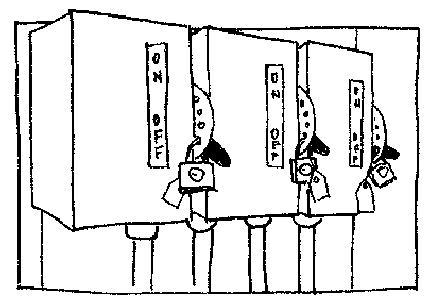
Figure 4-2. Shut off, lock, and tag the power to conveying equipment before servicing or unclogging it. Don't take the chance that the equipment may start or be started while you are working on it.
Power Take-Offs and Drivelines
Many conveyors are PTO-driven. Although it is common sense to avoid contact with a driveline, injuries still occur when people step across or reach over or under a PTO shaft or driveline (Figure 4-3).

Figure 4-3. Although it is common sense to avoid contact with a driveline, injuries still occur when workers step across or reach across or under a PTO shaft or driveline.
Even though you may take steps to avoid PTO contact, all shafts and drivelines should be shielded to help prevent injury if something should go wrong. The irregular shapes of the shafts and flexible joints entangle loose clothing and hair very easily. Shields that were designed to rotate separately from the shaft inside should do so easily. This condition should only be checked, of course, with the shaft stopped. Rotating shields should be smooth and free from cracks or sharp edges that could entangle loose clothing or hair.
The clothing worn while working around equipment, particularly PTO shafts, can also help to prevent entanglement. Work clothing should be well-fitting and zippered or buttoned, not open. Frayed clothes, jackets and sweatshirts with drawstrings, and boots or shoes with long shoelaces should be avoided. A shoelace or loose string, thread, flap of cloth, or the corner of a jacket can become entangled very easily.
Don't be tempted to change a conveyor's capacity by using an adapter to connect it to a PTO for which it was not intended. Using an improper PTO can cause the shaft or machinery to fail from overloading or overspeeding, and may cause severe injuries.
It is also important to use the correct hitching height and distance with PTO-powered implements. Check the owner's manual for the proper hitching position (Figure 4-4). Leave stationary implements hitched to the tractor so the hitching position does not change. An improper hitching height or distance can cause the telescoping section of the PTO shaft to separate or fail. When a PTO shaft separates or fails, the loose or broken ends can whip around violently and may cause severe injuries.
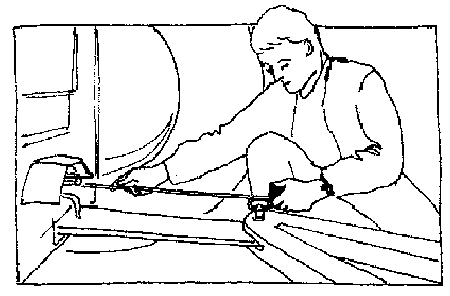
Figure 4-4. Check the owner's manual for the correct distance between the tractor and the equipment when using PTO-driven implements. An incorrect hitching distance can cause the drive shaft to fail or separate, causing serious injury.
Moving Augers and Elevators
Portable augers, elevators, and blowers also have hazards associated with their transport and placement. Augers and elevators can contact overhead power lines or collapse if not handled properly.
Before moving an auger or elevator, plan your path. Leave a minimum overhead clearance of 10 feet between a power line and the equipment. Keep the conveyor in its lowered position any time it is being moved. An auger or elevator in its lowest position has much less chance of tipping, collapsing, or contacting a power line.
If cables are used to raise and lower the auger, check them for broken strands or frayed sections. A broken cable can lead to an elevator collapse and possibly a death. Make sure that workers not absolutely necessary to raise the conveyor are a safe distance away.
The risk of electrocution from power line contact can be reduced by moving and positioning augers and elevators with a tractor or truck, not by hand. If an auger being moved by hand contacts a power line, the workers will become one of the paths the electricity takes to ground (Figure 4-5). Helpers who are located a safe distance away (20 feet or more) can watch for power lines.
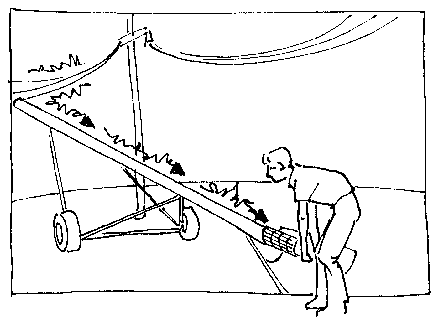
Figure 4-5. If an auger being moved by hand contacts an overhead power line, the workers will become one of the paths the electricity takes to ground. The risk of electrocution from power line contact can be reduced by moving and positioning augers and elevators with a tractor or truck, not by hand, and by maintaining at least 10 feet of clearance around all power lines.
If the conveyor should contact a wire, the driver should try to drive away to break electrical contact. Even if the vehicle cannot be moved, the driver should stay on it if at all possible. The soil immediately around equipment touching a power line will be energized. Soil near the vehicle will be at a higher voltage than soil farther away. If the driver climbs off the vehicle, he could connect two different voltage levels and become electrocuted. A driver who must leave the vehicle should jump away from the vehicle and wire, landing with both feet together while maintaining balance. The driver must then shuffle away from the vehicle using very short steps. Too large a step could put each foot in a different voltage zone and kill the driver (Figure 4-6).
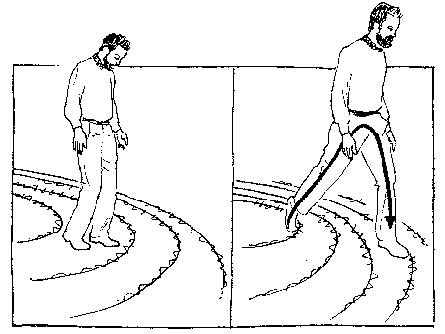
Figure 4-6. If a tractor and auger contact a power line, the soil around the equipment will be energized. A driver who must leave the vehicle should jump clear, landing with both feet together while maintaining balance. The driver must then shuffle away using very short steps (a). Too large a step could put each foot in a different voltage zone and electrocute the driver (b).
To further reduce the chance of electrocutions from power lines, you may want to consider having the lines placed underground.
Augers and elevators should be positioned on level ground as close as possible to the storage bin or building before they are raised. While the conveyor is being raised, its wheels should be free to roll and it should be left hitched to the tractor or truck. Blocking the wheels or allowing the hitch end of the conveyor to rise can cause the conveyor to collapse. Once the auger or elevator has been raised, it can be placed in its final position with the truck or tractor.
After the auger or elevator is in position, secure the bottom or hitch end so that it can't move and block both wheels. Make sure that the conveyor tongue is placing a downward force on the tractor or truck before unhitching it. An upward force could lead to tipping and collapse of the elevator.
Blower Tubes
When installing a grain or silage blower, the hazard of falling or being struck by falling objects can be reduced by assembling the blower tube on the ground, then raising the assembled pipe. While raising the pipe, make sure that the workers on ladders wear securely anchored safety harnesses. Safety harnesses are preferred to rope, since a loop of rope around the waist or under the arms can inflict severe injuries if it does stop a fall (Figure 4-7).
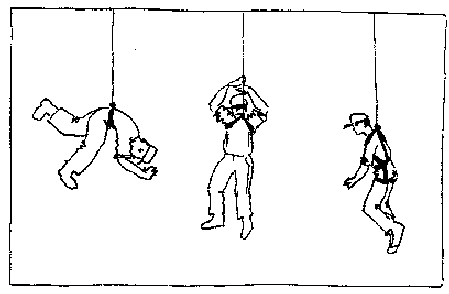
Figure 4-7. Safety harnesses are preferred to rope or a safety belt, since a belt or a loop of rope around the waist or under the arms can inflict severe injuries if a fall occurs.
Loaders
Front-end loaders and skid-steer loaders are often used to handle grain and silage. The main hazards associated with loaders are rollover injuries and crushing injuries from the bucket and bucket arms, material falling from the bucket, or material falling from a storage pile onto the loader and operator. To increase your loader's stability and reduce the chance of a rollover, use the manufacturer's recommended weighting. If you are using a tractor-mounted loader, space the wheels as far apart as possible to increase stability (Figure 4-8).
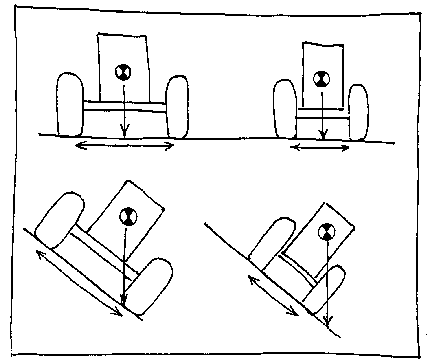
Figure 4-8. If you are using a tractor and loader, space the wheels as far apart as possible. A wider tread width tends to keep the center of gravity, the average position of the weight, between the wheels, making the tractor less likely to overturn.
Since raising the bucket raises the center of gravity, which makes an overturn more likely, keep the bucket height as low as possible when moving (Figure 4-9). Raise the bucket just before dumping. Use slow speeds and make slow turns or changes of direction when the bucket is loaded or raised. Doubling your forward speed increases the likelihood of an overturn by about four times. If you must go downhill with a loaded bucket, back down to prevent tipping to the front (Figure 4-10). To prevent side rollovers, try to load the bucket uniformly from side to side.
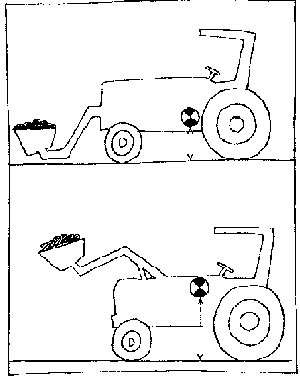
Figure 4-9. Raising a loader bucket raises the tractor's center of gravity, making the tractor top-heavy and more likely to overturn. Keep the bucket as low as possible when moving. Raise the load just before dumping it.
Since safe practices can greatly reduce, but not eliminate, the chance of a rollover, use front-end loaders on tractors with roll-over protective structures (ROPS) and seat belts whenever possible.

Figure 4-10. Back down slopes when the loader bucket is full to avoid tipping to the front. Load the bucket uniformly side to side to prevent sideways overturns.
Crushing injuries or deaths are also caused by getting caught under the loader bucket or between the loader and the tractor frame. To prevent a crushing injury to you or one of your helpers, make sure that the bucket is lowered to the ground, solidly blocked, or supported by the manufacturer's safety stop before servicing the tractor or loader or before attaching or removing the loader (Figure 4-11). Shut off the engine and take the key, unless otherwise specified in the owner's manual. After shutting off the engine, rock the loader's hydraulic control levers to relieve the pressure from the hydraulic cylinders. Sufficient pressure can be stored in the hydraulic system to inject fluid under the skin of a worker attempting to service the system, causing severe infection or injury.

Figure 4-11. To avoid crushing injuries, make sure that the bucket is on the ground or solidly blocked before working on the tractor or loader. Shut off the engine and take the key, unless otherwise specified by the manufacturer. With the engine off, rock the hydraulic control levers to relieve pressure in the hydraulic system so that high-pressure fluid isn't unexpectedly released.
It is a good practice to always lower the bucket to the ground and shut off the engine before dismounting or at the end of a work period, even if service is not planned. If the bucket is lowered and the engine is off, there is little chance of someone being crushed.
Publication #: 95-109
Disclaimer and Reproduction Information: Information in NASD does not represent NIOSH policy. Information included in NASD appears by permission of the author and/or copyright holder. More